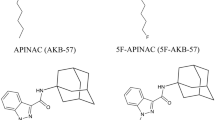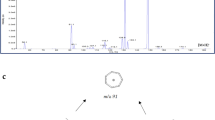Abstract
Despite the increasing relevance of synthetic cannabinoids as one of the most important classes within “New Psychoactive Substances”, there is still a lack of knowledge concerning their metabolism in humans. Due to the extensive metabolism of synthetic cannabinoids, metabolites are necessarily the best target analytes in urine, posing additional challenges to forensic analysis. The aims of this study were to identify appropriate urinary targets indicating intake of THJ-018 or THJ-2201 as well as to elucidate the most important cytochrome P450 isoenzymes within the metabolism of THJ-018 and THJ-2201 in vitro. For this purpose, the in vitro metabolism of THJ-018 and THJ-2201 was initially established using pooled human liver microsomes. The results obtained were compared to previously published in vitro results as well as to the results of the metabolic profiles from selected recombinant cytochrome P450 isoenzymes and from 23 urine samples from forensic cases. LC-HRMS was used to conduct product ion scans and to examine the metabolite spectra. For THJ-018, 17 different metabolite groups containing 33 different metabolites and isomers were detected after microsomal incubation, with the major metabolic pathways being monohydroxylation at the pentyl chain and of the naphthyl moiety as well as dihydroxylation of both residues. For THJ-2201, 19 different metabolite groups and 46 different metabolites and isomers were observed. The major metabolic pathways were monohydroxylation at the naphthyl moiety and oxidative defluorination. Significant contribution to the in vitro metabolism of THJ-018 and THJ-2201 originated from CYP2B6, CYP2C19, CYP3A4, and CYP3A5. As several cytochrome P450 isoenzymes are involved in the metabolism of these synthetic cannabinoids, a co-consumption with other drugs is unlikely to have an impact on their metabolism.






Similar content being viewed by others
References
Castaneto MS, Wohlfarth A, Desrosiers NA, Hartman RL, Gorelick DA, Huestis MA (2015) Synthetic cannabinoids pharmacokinetics and detection methods in biological matrices. Drug Metab Rev 47(2):124–174. https://doi.org/10.3109/03602532.2015.1029635
Wintermeyer A, Möller I, Thevis M, Jübner M, Beike J, Rothschild MA, Bender K (2010) In vitro phase I metabolism of the synthetic cannabimimetic JWH-018. Anal Bioanal Chem 398(5):2141–2153. https://doi.org/10.1007/s00216-010-4171-0
Sobolevsky T, Prasolov I, Rodchenkov G (2012) Detection of urinary metabolites of AM-2201 and UR-144, two novel synthetic cannabinoids. Drug Test Anal 4(10):745–753. https://doi.org/10.1002/dta.1418
Chimalakonda KC, Seely KA, Bratton SM, Brents LK, Moran CL, Endres GW, James LP, Hollenberg PF, Prather PL, Radominska-Pandya A, Moran JH (2012) Cytochrome P450-mediated oxidative metabolism of abused synthetic cannabinoids found in K2/Spice: identification of novel cannabinoid receptor ligands. Drug Metab Dispos 40(11):2174–2184. https://doi.org/10.1124/dmd.112.047530
Chimalakonda KC, Moran CL, Kennedy PD, Endres GW, Uzieblo A, Dobrowolski PJ, Fifer EK, Lapoint J, Nelson LS, Hoffman RS, James LP, Radominska-Pandya A, Moran JH (2011) Solid-phase extraction and quantitative measurement of omega and omega-1 metabolites of JWH-018 and JWH-073 in human urine. Anal Chem 83(16):6381–6388. https://doi.org/10.1021/ac201377m
Möller I, Wintermeyer A, Bender K, Jübner M, Thomas A, Krug O, Schänzer W, Thevis M (2011) Screening for the synthetic cannabinoid JWH-018 and its major metabolites in human doping controls. Drug Test Anal 3(9):609–620. https://doi.org/10.1002/dta.158
Hutter M, Broecker S, Kneisel S, Auwärter V (2012) Identification of the major urinary metabolites in man of seven synthetic cannabinoids of the aminoalkylindole type present as adulterants in 'herbal mixtures' using LC-MS/MS techniques. J Mass Spectrom 47(1):54–65. https://doi.org/10.1002/jms.2026
Hutter M, Moosmann B, Kneisel S, Auwärter V (2013) Characteristics of the designer drug and synthetic cannabinoid receptor agonist AM-2201 regarding its chemistry and metabolism. J Mass Spectrom 48(7):885–894. https://doi.org/10.1002/jms.3229
Kröner L, Spencer VC (2013) A pragmatic approach to detect SPICE-metabolites in urine with HPLC-MS/MS. Toxichem Krimtech 80:375–380
Moonhee J, Wonkyung Y, Hyeyoung C, Heyejin C, Sooyeun L, Eunmi K, Heesun C (2013) Monitoring of urinary metabolites of JWH-018 and JWH-073 in legal cases. Forensic Sci Int 231(1–3):13–19. https://doi.org/10.1016/j.forsciint.2013.03.053
Wohlfarth A, Scheidweiler KB, Castaneto M, Gandhi AS, Desrosiers NA, Klette KL, Martin TM, Huestis MA (2014) Urinary prevalence, metabolite detection rates, temporal patterns and evaluation of suitable LC-MS/MS targets to document synthetic cannabinoid intake in US military urine specimens. Clin Chem Lab Med 53(3):423–434. https://doi.org/10.1515/cclm-2014-0612
Moonhee J, Wonkyung Y, Shin I, Hyeyoung C, Heyejin C, Eunmi K (2014) Determination of AM-2201 metabolites in urine and comparison with JWH-018 abuse. Int J Legal Med 128(2):285–294. https://doi.org/10.1007/s00414-013-0884-x
Scheidweiler KB, Huestis MA (2014) Simultaneous quantification of 20 synthetic cannabinoids and 21 metabolites, and semi-quantification of 12 alkyl hydroxy metabolites in human urine by liquid chromatography-tandem mass spectrometry. J Chromatogr A 1327:105–117. https://doi.org/10.1016/j.chroma.2013.12.067
Scheidweiler KB, Jarvis MJ, Huestis MA (2015) Nontargeted SWATH acquisition for identifying 47 synthetic cannabinoid metabolites in human urine by liquid chromatography-high-resolution tandem mass spectrometry. Anal Bioanal Chem 407(3):883–897. https://doi.org/10.1007/s00216-014-8118-8
Watanabe S, Kuzhiumparambil U, Winiarski Z, Fu S (2016) Biotransformation of synthetic cannabinoids JWH-018, JWH-073 and AM2201 by Cunninghamella elegans. Forensic Sci Int 261:33–42. https://doi.org/10.1016/j.forsciint.2015.12.023
Diao X, Wohlfarth A, Pang S, Scheidweiler KB, Huestis MA (2015) High-resolution mass spectrometry for characterizing the metabolism of synthetic cannabinoid THJ-018 and its 5-Fluoro analog THJ-2201 after incubation in human hepatocytes. Clin Chem Lab Med 62(1):1–13. https://doi.org/10.1373/clinchem.2015.243535
Fietzke M, Thomas A, Beike J, Rothschild MA, Thevis M, Mercer-Chalmers-Bender K (2016) In vitro elucidation of the metabolic profile of the synthetic cannabinoid receptor agonists JWH-175 and JWH-176. Forensic Toxicol 34(2):353–362. https://doi.org/10.1007/s11419-016-0322-0
Peters FT (2014) Recent developments in urinalysis of metabolites of new psychoactive substances using LC–MS. Bioanalysis 6(15):2083–2107
Acknowledgements
Special thanks are directed to June Mercer-Chalmers-Bender for English language editing. The authors also thank Hilke Andresen-Streichert for her support.
Funding
This work was funded by the German Federal Ministry for Economic Affairs and Energy and the Central innovation program for medium-sized companies, respectively (grant number KF2429613MD3). An additional financial support also came from the German B.A.D.S. (Bund gegen Alkohol und Drogen im Straßenverkehr; Union against Alcohol and Drugs in Road Transport).
Author information
Authors and Affiliations
Corresponding author
Ethics declarations
Compliance with the law
All experiments comply with the current laws of the Federal Republic of Germany.
Conflict of interest
The authors declare that they have no conflict of interest.
Additional information
Publisher’s note
Springer Nature remains neutral with regard to jurisdictional claims in published maps and institutional affiliations.
Electronic supplementary material
ESM 1
(DOCX 29 kb)
Rights and permissions
About this article
Cite this article
Gaunitz, F., Thomas, A., Fietzke, M. et al. Phase I metabolic profiling of the synthetic cannabinoids THJ-018 and THJ-2201 in human urine in comparison to human liver microsome and cytochrome P450 isoenzyme incubation. Int J Legal Med 133, 1049–1064 (2019). https://doi.org/10.1007/s00414-018-1964-8
Received:
Accepted:
Published:
Issue Date:
DOI: https://doi.org/10.1007/s00414-018-1964-8




